 |  |
By David Kier
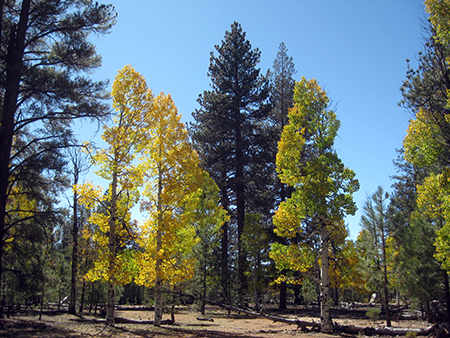
When one speaks about the fascinating peninsula of Baja California, images of cactus covered deserts, rugged off-road racing, the best sportfishing, surfing, or beach play, is typically what comes to mind. There is another face of Baja that is a far different place. One that has high mountain peaks that are covered with snow in the winter. The California Condor, once the master of these mountains has been brought back from near extinction and re-released into the wild here.
In 1967, the future site for Mexico’s largest observatory was chosen high on the ridge of the San Pedro Mártir, just a few miles from Baja’s largest mountain, El Picacho del Diablo (10,154’). Today, a paved road begins near sea level on Highway 1 and climbs over 9,000 feet. In 1970, the road to the mountaintop site had been made and the first telescope went into operation, others would follow. In 1979, Mexico’s largest telescope was installed with its 84-inch mirror. In 2017, three telescopes that make up the TAOS II Project (searching for small objects beyond the orbit of Neptune) were installed.
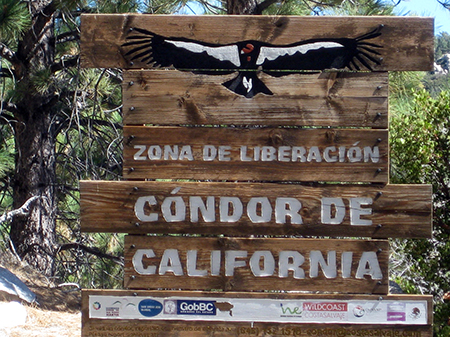
The Sierra San Pedro Mártir mountain range was named for the 1794 Spanish mission founded there. Originally established at 6,785’, within three months the Dominican padres moved the mission 7 miles south and nearly 2,000’ lower in elevation because of the frosts encountered so high up. Over the next seventeen years, the mission added buildings, irrigation canals, raised corn and cattle, but the population remained less than 100 Native converts for most of its years of operation. The mission was finally closed during a harsh winter storm in 1811. Mexico’s independence was achieved in 1821 and that all but ended the Spanish mission program.
In the 1880s, Mexico welcomed pioneering families to help develop the sparsely populated peninsula. The Johnsons, originally from Denmark and the Melings from Norway, arrived and began ranching and mining the region around Colonet and San Telmo. Prospecting for gold and other minerals was high on the agenda for survival in the years of draught for these families. Gold was discovered at Arroyo Socorro and in 1894, Harry Johnson constructed a ditch 18 miles long to bring water to Socorro allowing year round mining. In the following year, so much gold was removed, the cost of the enormous feat of hydro-engineering was recovered. Socorro was a busy mine town for several years. In the valley below Socorro was Rancho San José where members of the Johnson family spent time between their San Antonio de Mar ranch near Colonet, and Socorro. Harry Johnson bought Rancho San José in 1910 and in the following year, the revolt led by Pancho Villa burned down the ranch. Once the small revolution was over, the ranch was rebuilt, and Johnson sold the Socorro mine. In 1924, the ranch became known as the Meling Ranch when Harry Johnson’s daughter Aida (who married Salve Meling in 1913) bought the ranch from her mother.
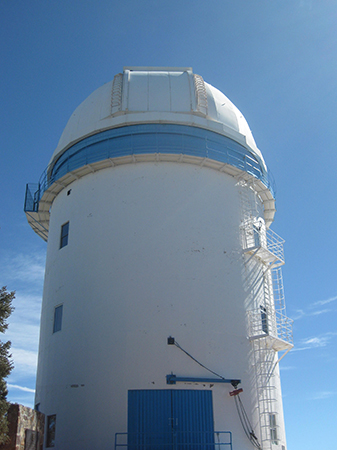
Beginning in 1929, Charles Edward Utt transplanted a native Baja California species of Rainbow Trout from San Antonio Canyon to the other running streams of the Sierra San Pedro Mártir. The fascinating story can be read
here.
Following World War II, Baja California received a new influx of visitors traveling by the new four-wheeldrive sensation, the ‘jeep,’ and even more travelers came flying their private airplanes as dirt runways popped up everywhere in Baja. The roads were so bad that flying was the only option for most. The Meling Ranch continues to welcome fly-in guests at its 3,000-foot runway. However, with paved highways now replacing dirt roads and drug trafficking causing the closure of most dirt runways, the land-based traveler has become the primary client for guest ranches and resorts in Baja.
Paving the road to the San Pedro Mártir National Park and the observatories was completed around 2007. With recent astronomical construction in 2017, the road has been well maintained. However, it has several steep grades and is narrow as it climbs from nearly sea-level to over 9,280 feet (2,828 meters) in 62 miles (100 kilometers). Large motorhomes or travel trailers are not advised for that reason.
A visit to the pine forests of Baja California is a wonderful experience. Seeing condors circling overhead is quite a sight, as well. Should you be able to drive the final 3 kilometers beyond the gate, to the observatory, you could be rewarded with one of Baja’s most fantastic views. The fee to enjoy the park is very reasonable at 64 pesos (under 4 dollars) per person. Many camping sites are located just beyond the entrance station. There are cabins available as well, but bring a tent or camper should they be unavailable.
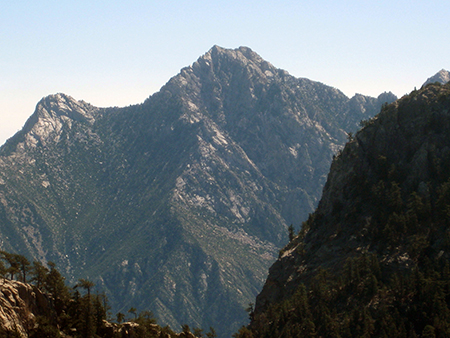
There are day-use trails and side roads inside the park, but camping is restricted to the sites near the entrance station. Expect far cooler temperatures at the 8,000-foot level and brief summer rains and lightning strikes can be a daily event. Read more in Graham Mackintosh’s excellent book, Nearer My Dog To Thee.
Camping, rooms, and meals are also available at Rancho Meling and Rancho El Coyote. The road between Rancho El Coyote and Mike’s Sky Rancho has not been maintained and was badly washed out from last winter’s heavy rains. It may only be passable to motorcycles or ‘rock-crawler’ style 4x4s.
The following conditions were noted in October 2017:
ROAD LOG: Distance in miles (and kilometers)
0.0 Highway 1 at Km. 140.5, elevation 130'. The well-signed junction is 87 miles south of Ensenada.
4.2 (Km. 7) Narrow bridge
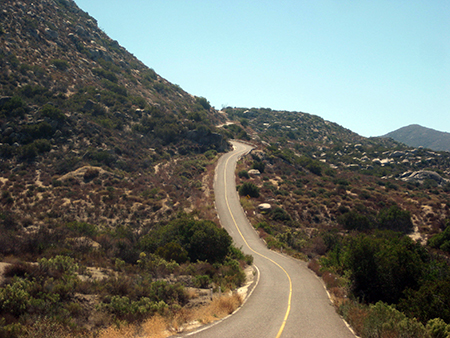
5.6 (Km. 9.5) San Telmo (now a ghost town) was an important visita old Mission Santo Domingo and a farming supply center until recent years when many have moved down to Highway 1 for more opportunity.
11.3 (Km. 18+) Hacienda Sinaloa a town of farm workers with one small store.
17.0 (Km. 27.5) Road right goes to the old Valladares gold mines (18 miles) and El Potrero (27 miles).
17.6 (Km. 28.5) Signed road left to Ranchos (Las Choyas, Cortez, El Papalote). Road begins a steep climb.
22.0 (Km.35+) 1,000' elevation.
24.0 (Km. 38.5) 2,000' elevation.
30.3 (Km. 49) Road north to El Coyote guest ranch, 4.9 miles (rooms, camping, meals).
30.6 (Km. 49.5) Road to right to Meling Ranch, a guest ranch with a long history. Rooms, meals, camping, airstrip.
34.0 (Km. 55) 3,000' elevation.
39.0 (Km. 63) 4,000' elevation.
39.3 (Km. 63.5+) Road south to El Potrero.
40.6 (Km. 66) Socorro mine site. Not much left from the 1894-1910 when the Johnson family worked the placer goldfield.
41.6 (Km. 67+) Road left, signed to La Joya. Badly eroded from last winter's rains, this ranch and the former Dark Skies Inn (Rancho La Concepción) was once reached this way, but today may be impassable.
43.4 (Km. 70) 5,000' elevation.
45.0 (Km. 72.5) 6,000' elevation.
45.2 (Km. 73) Fire break road to the right (yellow gate).
45.8 (Km. 73.5+) Road right 0.3 mi. to the former Los Manzanos RV Park/Campground. Abandoned.
46.3 (Km.74.5+) La Cienega de Soto, rental cabin.
48.1 (Km. 77.5) Former park entrance payment gate, ex-ranger station (6,800').
48.6 (Km. 78+) 7,000' elevation.
51.0 (Km. 82+) 8,000' elevation.
51.7 (Km. 83.5) Park Entrance Payment Ranger Station 'La Corona'. Elevation: 8,259'.
52.0 (Km. 84) Campo Cacomixtle, El Condor, Cimarron, and more, on both sides of the highway.
53.5 (Km. 86.5) Capilla San Pedro. A small chapel on a hilltop.
56.3 (Km. 91) Road south for La Tasajera (10 km.). Locked gate at Mile 1.9.
56.8 (Km. 91.5) Museum (closed).
57.8 (Km. 93+) The Aguaje del Burro road to the right goes 2.0 miles to a covered spring. This was an old cattle camp.
58.2 (Km. 93.5+) Mirador El Altar road right (elev. 8,000'). It is 0.3 mi. to the El Mirador trail. A right fork just off the highway goes 2.2 miles to a pretty area.
58.9 (Km. 94.5+) Pass a military camp and a side road left to the Venado Blanco trail.
60.3 (Km. 97.5) Parking area (left) and gate restricting access to the observatories. 8,705'. A phone box on the left to request passage. It is 3 kilometers and over 500' higher to the end of the road at Mexico's largest telescope.
61.2 (Km. 99) 9,000' elevation.
62.1 (Km. 100+) Elev. 9,280'. The highest point reached by automobile in Baja California. The national observatory.
About David
David Kier is a veteran Baja traveler, author of 'Baja California - Land Of Missions' and co-author of 'The Old Missions of Baja and Alta California 1697-1834'. Visit the Old Missions website.

Quick and easy insurance, works great. Love the directions on the website to assist getting back...

Use this Insurance Every Time I go to Baja .If you call them they have good service or you can get...

Baja is the best. Canadians, we insure our boat and car online through them 2 years now. Easy to...